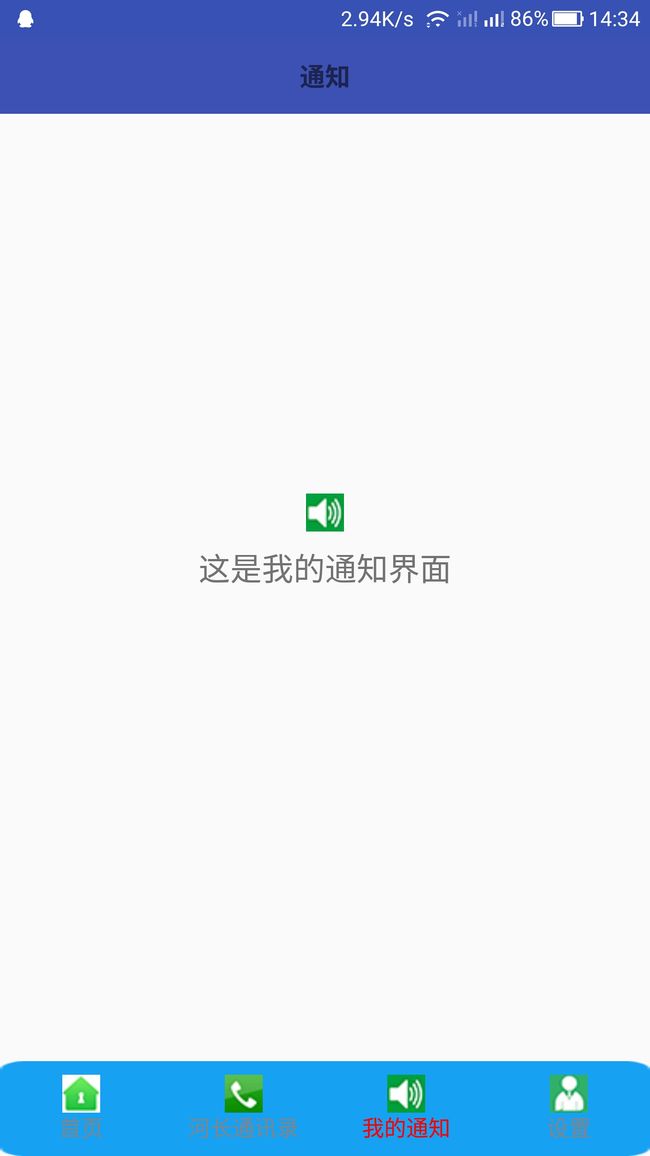Android实现仿QQ界面底部控制栏和头部标题
界面类似上图,点击下部控制栏按键,会对应响应不同的界面
本文参考郭神的文章进行应用,原文链接:http://blog.csdn.net/guolin_blog/article/details/13171191
1、内容界面是应该写在Fragment的布局里的。打开或新建activity_main.xml作为程序的主布局文件,在里面加入如下代码:
主界面代码主要分为两部分,第一个部分就是FrameLayout,这里只是给FrameLayout的id设置成content,并没有在里面添加任何具体的内容,因为具体的内容是要在后面动态进行添加的。第二个部分就是FrameLayout下面的LinearLayout,这个LinearLayout中包含的就是整个类似于TabHost的布局。可以看到,我们将这个LinearLayout又等分成了四份,每一份中都会显示一个ImageView和一个TextView。ImageView用于显示当前Tab的图标,TextView用于显示当前Tab的标题,这个效果就会和QQ非常得类似。
2、分别实现四个Fragment和它们的布局了。新建一个message_layout.xml作为消息界面的布局,代码如下所示:
这个布局就相对简单多了,只是在屏幕最上方加了一个”首页“的标题,这里要注意的是需要把主题换成NoActionBar模式,模式代码如下:
3、然后要去创建对应这个布局的Fragment。新建MessageFragment继承自Fragment,代码如下所示:
public class MessageFragment extends Fragment {
private TextView inspect;
private TextView record;
private TextView message;
private TextView data;
private TextView photo;
private TextView files;
@Override
public View onCreateView(LayoutInflater inflater, ViewGroup container,
Bundle savedInstanceState) {
View messageLayout=inflater.inflate(R.layout.message_layout,container,false);
inspect= (TextView) messageLayout.findViewById(R.id.inspect);
inspect.setOnClickListener(new View.OnClickListener() {
@Override
public void onClick(View v) {
Intent intent=new Intent(getActivity(),InspectActivity.class);
startActivity(intent);
}
});
return messageLayout;
}
}这里我还在fragment里面添加了一个点击事件,绑定的时候要注意前面加上messagelayout,还有跳转的时候Intent里面注意加上getActivity
4、后面就是依葫芦画瓢,把其它几个Fragment以及对应的布局创建出来。新建contacts_layout.xml作为联系人界面的布局
5、们就把每一个Fragment,以及它们所对应的布局文件都创建好了。接下来也就是最关键的步骤了,打开或新建MainActivity作为主Activity,代码如下所示:
public class MainActivity extends BaseActivity implements View.OnClickListener{
private TextView inspect;
private TextView record;
private TextView message;
RadioButton address;
private GridView mGridView;
private String IMAGE_ITEM = "imgage_item";
private String TEXT_ITEM = "text_item";
/**
* 用于展示首页的Fragment
*/
private MessageFragment messageFragment;
/**
* 用于展示联系人的Fragment
*/
private ContactsFragment contactsFragment;
/**
* 用于展示通知的Fragment
*/
private NoticeFragment newsFragment;
/**
* 用于个人设置的Fragment
*/
private PersonFragment settingFragment;
/**
* 首页界面布局
*/
private View messageLayout;
/**
* 联系人界面布局
*/
private View contactsLayout;
/**
* 通知界面布局
*/
private View noticeLayout;
/**
* 个人设置界面布局
*/
private View personLayout;
/**
* 在Tab布局上显示消息图标的控件
*/
private ImageView messageImage;
/**
* 在Tab布局上显示联系人图标的控件
*/
private ImageView contactsImage;
/**
* 在Tab布局上显示动态图标的控件
*/
private ImageView newsImage;
/**
* 在Tab布局上显示设置图标的控件
*/
private ImageView settingImage;
/**
* 在Tab布局上显示消息标题的控件
*/
private TextView messageText;
/**
* 在Tab布局上显示联系人标题的控件
*/
private TextView contactsText;
/**
* 在Tab布局上显示动态标题的控件
*/
private TextView newsText;
/**
* 在Tab布局上显示设置标题的控件
*/
private TextView settingText;
/**
* 用于对Fragment进行管理
*/
private FragmentManager fragmentManager;
@Override
protected void onCreate(Bundle savedInstanceState) {
super.onCreate(savedInstanceState);
requestWindowFeature(Window.FEATURE_NO_TITLE);
setContentView(R.layout.activity_main);
// 初始化布局元素
initViews();
fragmentManager = getSupportFragmentManager();
// 第一次启动时选中第0个tab
setTabSelection(0);
}
/**
* 在这里获取到每个需要用到的控件的实例,并给它们设置好必要的点击事件。
*/
private void initViews() {
messageLayout = findViewById(R.id.message_layout);
contactsLayout = findViewById(R.id.contacts_layout);
noticeLayout = findViewById(R.id.news_layout);
personLayout = findViewById(R.id.setting_layout);
messageImage = (ImageView) findViewById(R.id.message_image);
contactsImage = (ImageView) findViewById(R.id.contacts_image);
newsImage = (ImageView) findViewById(R.id.news_image);
settingImage = (ImageView) findViewById(R.id.setting_image);
messageText = (TextView) findViewById(R.id.message_text);
contactsText = (TextView) findViewById(R.id.contacts_text);
newsText = (TextView) findViewById(R.id.news_text);
settingText = (TextView) findViewById(R.id.setting_text);
messageLayout.setOnClickListener(this);
contactsLayout.setOnClickListener(this);
noticeLayout.setOnClickListener(this);
personLayout.setOnClickListener(this);
}
@Override
public void onClick(View v) {
switch (v.getId()){
case R.id.message_layout:
// 当点击了消息tab时,选中第1个tab
setTabSelection(0);
break;
case R.id.contacts_layout:
// 当点击了联系人tab时,选中第2个tab
setTabSelection(1);
break;
case R.id.news_layout:
// 当点击了通知tab时,选中第3个tab
setTabSelection(2);
break;
case R.id.setting_layout:
// 当点击了设置tab时,选中第4个tab
setTabSelection(3);
break;
default:
break;
}
}
/**
* 根据传入的index参数来设置选中的tab页。
*
* @param index
* 每个tab页对应的下标。0表示首页,1表示联系人,2表示通知,3表示个人设置。
*/
private void setTabSelection(int index) {
// 每次选中之前先清楚掉上次的选中状态
clearSelection();
// 开启一个Fragment事务
FragmentTransaction transaction=fragmentManager.beginTransaction();
// 先隐藏掉所有的Fragment,以防止有多个Fragment显示在界面上的情况
hideFragments(transaction);
switch (index){
case 0:
// 当点击了首页tab时,改变控件的图片和文字颜色
messageImage.setImageResource(R.drawable.first_page);
messageText.setTextColor(Color.RED);
if (messageFragment == null) {
// 如果MessageFragment为空,则创建一个并添加到界面上
messageFragment = new MessageFragment();
transaction.add(R.id.content, messageFragment);
} else {
// 如果MessageFragment不为空,则直接将它显示出来
transaction.show(messageFragment);
}
break;
case 1:
// 当点击了联系人tab时,改变控件的图片和文字颜色
contactsImage.setImageResource(R.drawable.telephone);
contactsText.setTextColor(Color.RED);
if (contactsFragment == null) {
// 如果ContactsFragment为空,则创建一个并添加到界面上
contactsFragment = new ContactsFragment();
transaction.add(R.id.content, contactsFragment);
} else {
// 如果ContactsFragment不为空,则直接将它显示出来
transaction.show(contactsFragment);
}
break;
case 2:
// 当点击了通知tab时,改变控件的图片和文字颜色
newsImage.setImageResource(R.drawable.notice);
newsText.setTextColor(Color.RED);
if (newsFragment == null) {
// 如果NewsFragment为空,则创建一个并添加到界面上
newsFragment = new NoticeFragment();
transaction.add(R.id.content, newsFragment);
} else {
// 如果NewsFragment不为空,则直接将它显示出来
transaction.show(newsFragment);
}
break;
case 3:
// 当点击了设置tab时,改变控件的图片和文字颜色
settingImage.setImageResource(R.drawable.person);
settingText.setTextColor(Color.RED);
if (settingFragment == null) {
// 如果SettingFragment为空,则创建一个并添加到界面上
settingFragment = new PersonFragment();
transaction.add(R.id.content, settingFragment);
} else {
// 如果SettingFragment不为空,则直接将它显示出来
transaction.show(settingFragment);
}
break;
default:
break;
}
transaction.commit();
}
/**
* 清除掉所有的选中状态。
*/
private void clearSelection() {
messageImage.setImageResource(R.drawable.first_page);
messageText.setTextColor(Color.parseColor("#82858b"));
contactsImage.setImageResource(R.drawable.telephone);
contactsText.setTextColor(Color.parseColor("#82858b"));
newsImage.setImageResource(R.drawable.notice);
newsText.setTextColor(Color.parseColor("#82858b"));
settingImage.setImageResource(R.drawable.person);
settingText.setTextColor(Color.parseColor("#82858b"));
}
/**
* 将所有的Fragment都置为隐藏状态。
*
* @param transaction
* 用于对Fragment执行操作的事务
*/
private void hideFragments(FragmentTransaction transaction){
if (messageFragment != null) {
transaction.hide(messageFragment);
}
if (contactsFragment != null) {
transaction.hide(contactsFragment);
}
if (newsFragment != null) {
transaction.hide(newsFragment);
}
if (settingFragment != null) {
transaction.hide(settingFragment);
}
}}6、在onCreate()方法中先是调用了initViews()来获取每个控件的实例,并给相应的控件设置好点击事件,然后调用setTabSelection()方法设置默认的选中项,这里传入的0说明默认选中第1个Tab项。
那么setTabSelection()方法中又是如何处理的呢?可以看到,首先第一步是调用clearSelection()方法来清理掉之前的选中状态,然后开启一个Fragment事务,并隐藏掉所有的Fragment,以防止有多个Fragment显示在界面上。接下来根据传入的index参数判断出选中的是哪一个Tab项,并改变该Tab项的图标和文字颜色,然后将相应的Fragment添加到界面上。这里注意一个细节,我们添加Fragment的时候并没有使用replace()方法,而是会先判断一下该Fragment是否为空,如果是空的则调用add()方法添加一个进来,如果不是空的则直接调用show()方法显示出来即可。那么为什么没有使用replace()方法呢?这是因为replace()方法会将被替换掉的那个Fragment彻底地移除掉,该Fragment的生命周期就结束了。当再次点击刚才那个Tab项的时候,就会让该Fragment的生命周期重新开始,onCreate()、onCreateView()等方法都会重新执行一遍。这显然不是我们想要的,也和ActivityGroup的工作原理不符,因此最好的解决方案就是使用hide()和show()方法来隐藏和显示Fragment,这就不会让Fragment的生命周期重走一遍了。
